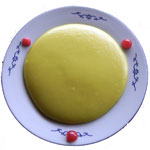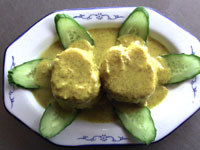|
Mix and match
By Ye Jun ( Beijing Weekend)
Updated: 2004-03-22 11:53
 What comes to your mind when people talk about Beijing-style food? What comes to your mind when people talk about Beijing-style food?
Peking roast duck, perhaps, or hot pot, or maybe the snacks found at Donghuamen and Wangfujing food streets?
Many people are in fact confused about just what can be called Beijing-style food. That's probably because there are so many different cuisines available in the capital city.
In fact, Beijing-style food is a mixture of Shandong-style food (lu cuisine) and Muslim-style food.
The origin of Beijing-style food can be traced back to the Liao Dynasty (907-1125), when the northern Chinese ethnic groups started to bring food from northeastern China and the Mongol Plain to the city.
Since the Yuan Dynasty (1271-1368), Shandong-style food, a representative of northern Chinese cuisine at that time, began to be introduced to Beijing. The style came into favour with the imperial family and adapted itself to the taste of Beijingers, all the time being influenced by other styles of Chinese cuisine.
 By the Qing Dynasty (1644-1911), the food style of the Manchu minority was again absorbed into Beijing cuisine. By the Qing Dynasty (1644-1911), the food style of the Manchu minority was again absorbed into Beijing cuisine.
So the present Beijing-style food incorporates elements of Shandong, Chinese northern ethnic groups and Manchu food styles.
The truth is that Beijing style is a mixed cuisine itself.
Some specialities though are undoubtedly unique to Beijing.
Fried hawthorn fruit (chao hong guo)
Actually this is not fried but boiled, with seeds taken out, served cool and dotted with cabbage slices. It is sweet and sour.
Fried mung bean curd (ma dou fu)
This is made of bits of mung bean fried with vegetable oil. It is dotted with green beans.
Fried mung bean flour flakes (zha guan chang)
This is made of steamed mung beans, cut it into thin, round flakes and fried with pork oil. It is served with garlic juice.
Mung bean juice (dou zhi) and crispy loops (jiao quan)
Douzhi smells like smelly bean curd and tastes sour.Usually it comes with fried crispy loop and Chinese pickles. Tip: drink it hot!
Chinese cabbage with mustard (jie mo dui'er)
This is made with Chinese cabbage marinaded with sugar and mustard. Crispy and super spicy, it evokes tears almost instantly!
Steamed mung bean mash and eggs (san bu zhan)
Tasting fragrant and slightly sweet, this is made of mung bean mash and egg yolks.
|
Old Beijing eats
|
Hai Wan Ju
Location: 5/F, Ganjiakou Mansion, Haidian District
Tel: 8839-2073 |
Da Cai Lou
Location: No 8 Beitoutiao, Tuanjiehu, Chaoyang District
Tel: 6582-1916 |
Yi Wan Ju
Location: No 5, Area 4, Anhuili, Asian Games Village, 200 metres to the east of Asian Games Village Post Office
Tel: 6491-1258 |
Dao Jia Chang
No 20 North of Guangximen, east side of Ito Yokado Shilipu Store, Chaoyang District
Tel: 6557-0115 |
Old Beijing Fried Brown Sauce Noodles King (Lao Beijing Zha Jiang Mian Da Wang )
On entering, shop assistants might surprise you by their loud cries of welcome, a ritual following old Beijing tradition.
The restaurant is decorated with traditional Beijing paintings and done out with local furniture.
In addition to characteristic Beijing dishes, fried brown sauce noodles are a big attraction here.
Location: No 29 Chongwenmen Waidajie, Chongwen District
Tel: 6705-6705
Some other restaurants of similar style |
Fu Jia Lou
Decorated in a typical Beijing style and serving Beijing-style food, the restaurant offers a wide variety of local dishes and traditional snacks. This serves more dishes than average noodles restaurants.
Location: No 23 Dongsi Shitiao, 200 metres to the west of Poly Plaza, Dongcheng District
Tel: 8403-7831 |
|
